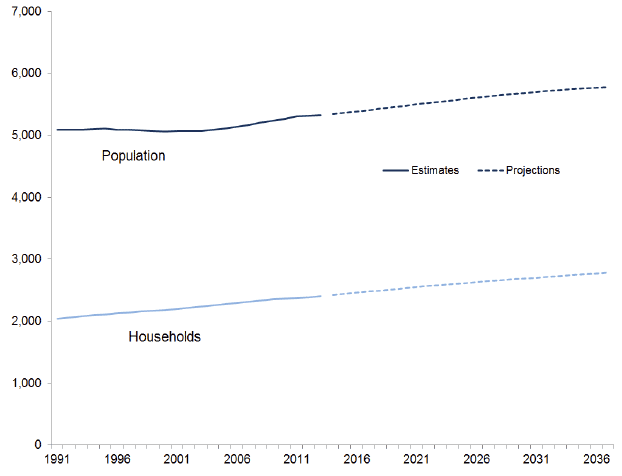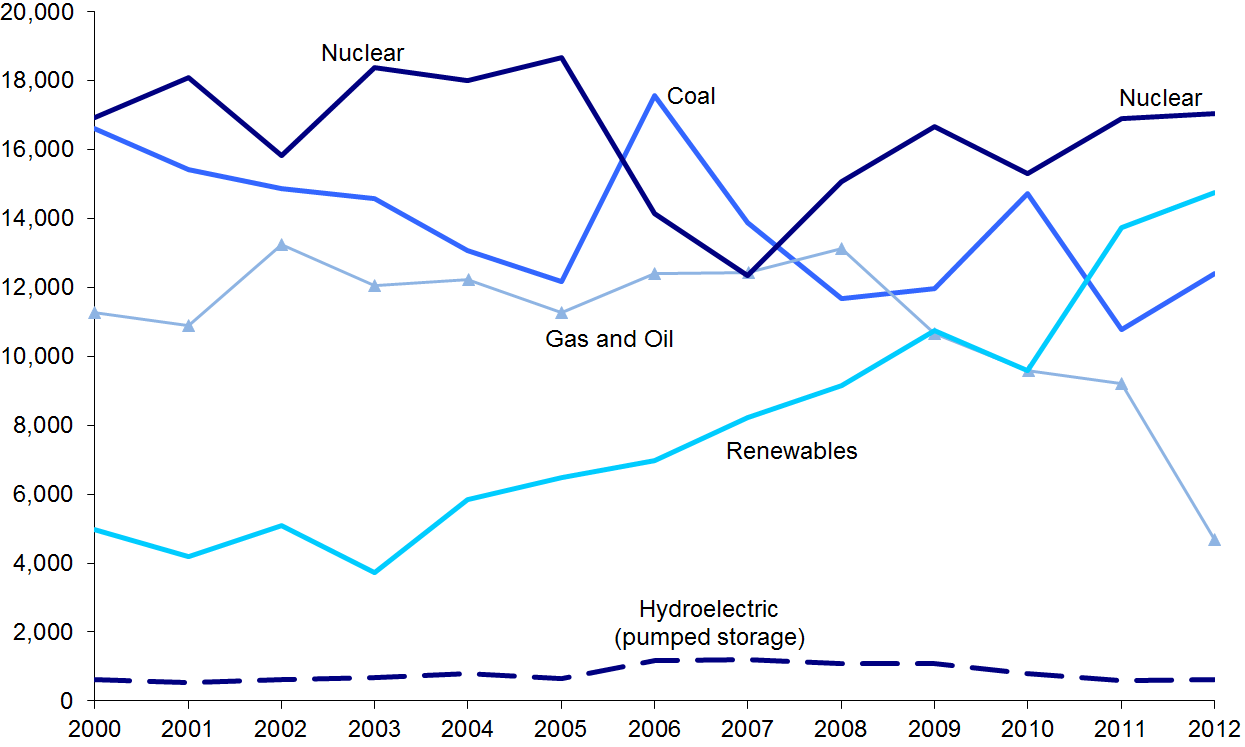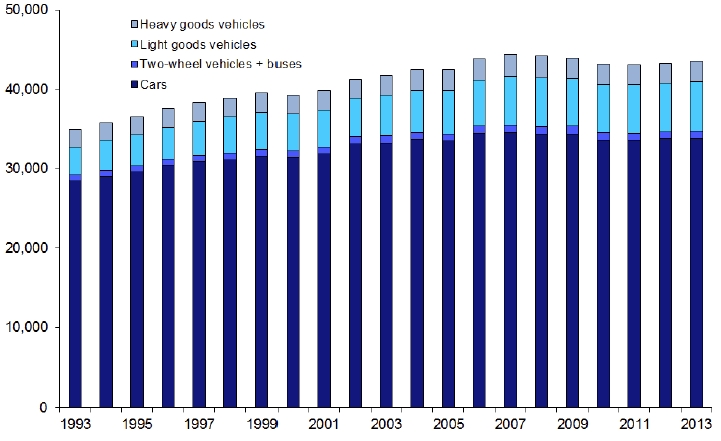Key Scottish Environment Statistics 2014
This publication aims to provide an easily accessible reference document which offers information on a wide range of environmental topics. It covers key datasets on the state of the environment in Scotland, with an emphasis on the trends over time wherever possible. The data are supplemented by text providing brief background information on environmental impacts, relevant legislation and performance against national and international targets.
This document is part of a collection
Background
Population and Households: 1991-2037
Population/Households (thousands)[1]

People and households are important consumers of energy and water, therefore the population and number of households will have an effect on the environment. The population of Scotland declined steadily through most of the 1980s, followed by small increases in the seven years up to 1995. The population then decreased to 5.07 million in 2002, but it has since increased to 5.33 million in 2013. Population estimates are rebased with each census to ensure a consistent time series. The estimates for 2002 to 2010 were revised following the results of the 2011 Census.
The latest projections indicate that the population will rise by 8.5% to 5.78 million in 2037. This trend is consistent with the overall UK population, which is also projected to increase but at a greater rate.[2]
The number of households rose by 359,000 (18%) between 1991 and 2013, whereas the population grew by 5%. The higher growth in household numbers reflects the fact that household structures are changing, with fewer people per household. Projections based on 2012 figures suggest that the number of households in Scotland will increase by 16% between 2013 and 2037, to 2.78 million[3]. This will contribute significantly to the demand for housing, not all of which can be accommodated on previously developed land. It is also likely to result in greater demand for goods and services which tend to be consumed on a household basis rather than an individual basis.
Source: National Records of Scotland / Metadata - Population / Households
Gross Domestic Product (GDP)R,[4]: 1998-2013
Scottish GDP at basic prices (2011=100)
![Gross Domestic Product (GDP)R,[4]: 1998-2013 Gross Domestic Product (GDP)R,[4]: 1998-2013](/binaries/content/gallery/publications/statistics/2014/08/key-scottish-environment-statistics-2014/00458368.gif)
Scotland's Gross Domestic Product (GDP) is the main indicator of Scotland's economic performance. The GDP index is a short-term measure of output growth expressed in real terms. The estimates are adjusted for regular seasonal effects, and appropriately deflated to represent changes in the volume of economic activity rather than the value.
Over the 2013 calendar year, GDP in Scotland grew by 1.9%. This followed similar growth during 2012.
Over the 15 year time series between 1998 and 2013, the Scottish GDP index increased from 79.3 to 102.1, representing an average annual growth rate of 1.7%. However, this has not been a smooth increase and has been punctuated by some disruption. Most notably, following the deterioration in global economic conditions, Scottish GDP fell by 5.6% between the second quarter of 2008 and the third quarter of 2009. Scottish GDP returned to its pre-recession level during the first quarter of 2014.
Source: Scottish Government / Metadata
Electricity Generation by SourceR: 2000-2012
Electricity generated (GigaWatt hours) [5],[6]

The combustion of fossil fuel, especially coal, is a major contributor to carbon dioxide emissions. Carbon dioxide is one of a basket of six greenhouse gases that Scotland is committed to reduce under the Climate Change (Scotland) Act 2009.[7]
In 2012, Scotland generated 49,498 GWh of electricity, 3.4% less than in 2011. Renewable electricity generation increased by approximately 7% over this period, accounting for 30% of the total generated. The increase since 2000 is mainly the result of a rise in the amount of electricity generated by wind power. Hydro generation accounted for 33% of Scotland's renewable electricity generation in 2012, and was 9% less than 2011 levels due to drier weather. Scotland generated 14,756 GWh of electricity from renewable sources in 2012. This equated to 40% of the gross consumption[8] of electricity in Scotland, compared with 12% in 2000 and 36% in 2011.[9]
Fossil fuels accounted for 35% of Scotland's electricity generation in 2012. Coal and gas are the two main fossil fuels used for electricity generation, with oil used to a lesser extent. The mix of fossil fuels used in any year is affected by relative fuel prices. There was a slight upward trend in generation from gas and oil between 2005 and 2008, but this dropped in 2009, and in 2012 reached its lowest level since 2000 with a 49% drop from 2011. Electricity generated by coal increased by 15% in 2012 compared to 2011.
Nuclear power does not emit greenhouse gases although its use raises other environmental issues, including the long-term disposal of spent fuel. In 2012, 34% of electricity generated in Scotland was from nuclear power stations, compared with 33% in 2011. Scotland's two nuclear stations both currently have a decommissioning date of 2023. No new nuclear power stations are currently planned.
Source: Department of Energy and Climate Change / Scottish Government / Metadata
Motor Traffic on All Roads: 1993-2013
Million vehicle kilometres

The pollutants emitted by road transport are a major contributor to poor air quality, which damages human and ecosystem health.[10] Fine particulate matter and nitrogen dioxide (NO2) are the pollutants of most concern, due primarily to their effects on human health. Oxides of nitrogen (NOx), of which NO2 is a component, contribute to the formation of ground level ozone that can impact on both human health and plant growth. Transport emissions also contain carbon dioxide and other greenhouse gases (GHGs), which contribute to climate change. Improvements in fuel efficiency and switching to newer cleaner fuel sources are helping to achieve reductions in GHG emissions and concentrations of atmospheric pollutants.
Since 1993, the volume of motor traffic on roads in Scotland has increased by 25% to some 43.5 billion vehicle kilometres in 2013. However, since 2007 there has been a reduction in motorised road traffic with 2011 levels 3% less than the peak in 2007. The volume of motor traffic increased in both 2012 and 2013 but remains 2% below the 2007 peak. In 2013, major roads (motorways and 'A' roads) accounted for approximately two thirds of the volume of motor traffic in Scotland. In addition, minor roads ('B', 'C' and unclassified) accounted for 14.5 billion vehicle kilometres of traffic. Much of the growth in road traffic has been by light goods vehicles, which showed a 76% increase in vehicle kilometres since 1993.
Source: Department for Transport / Metadata
Contact
Email: Kirsty Ciclitira
There is a problem
Thanks for your feedback